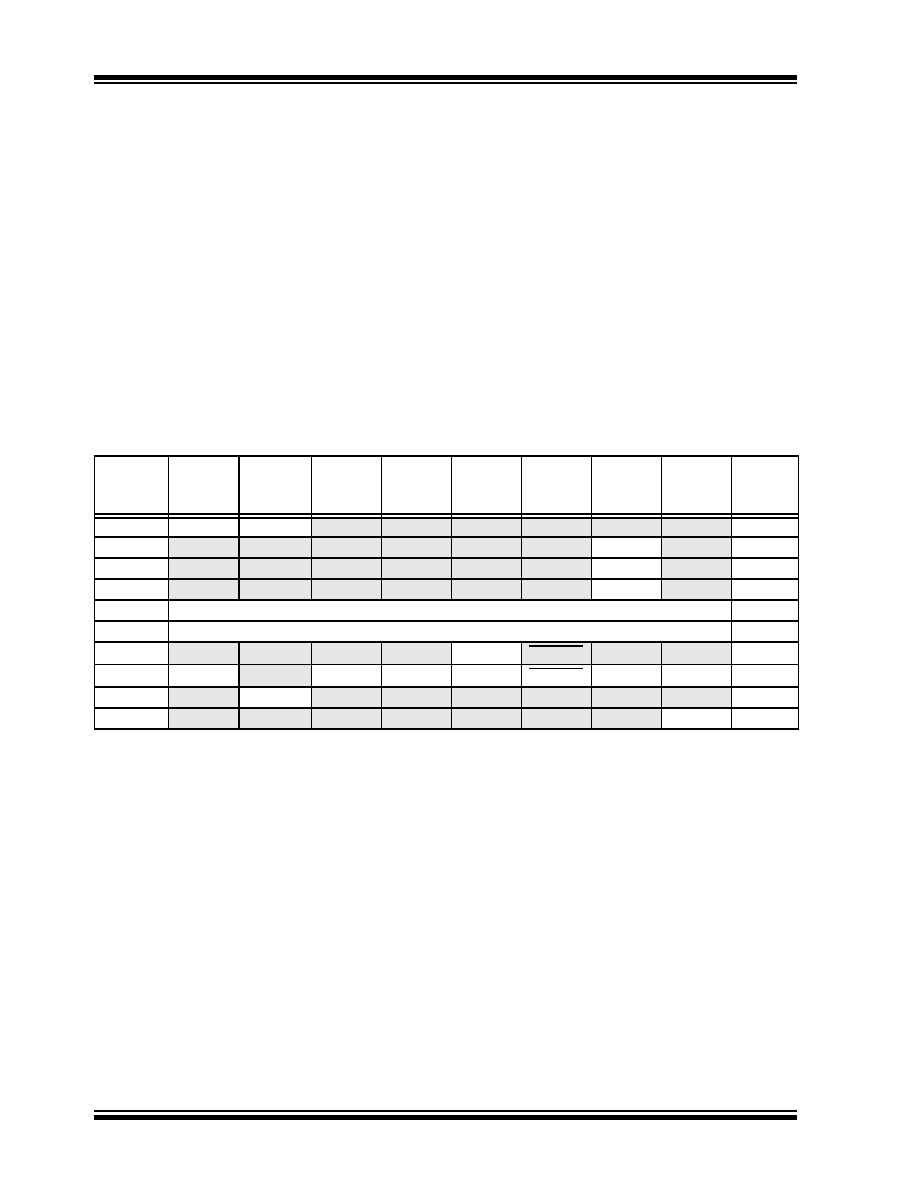- 您现在的位置:买卖IC网 > Sheet目录3876 > PIC18F14K50-I/SS (Microchip Technology)IC PIC MCU FLASH 8KX16 20-SSOP

PIC18F/LF1XK50
DS41350E-page 116
Preliminary
2010 Microchip Technology Inc.
13.5
Resetting Timer3 Using the CCP
Special Event Trigger
If CCP1 module is configured to use Timer3 and to gen-
erate a Special Event Trigger in Compare mode
(CCP1M<3:0>), this signal will reset Timer3. It will also
start an A/D conversion if the A/D module is enabled
(see Section 17.2.8 “Special Event Trigger” for more
information).
The module must be configured as either a timer or
synchronous counter to take advantage of this feature.
When used this way, the CCPR1H:CCPR1L register
pair effectively becomes a period register for Timer3.
If Timer3 is running in Asynchronous Counter mode,
the Reset operation may not work.
In the event that a write to Timer3 coincides with a
Special Event Trigger from a CCP module, the write will
take precedence.
TABLE 13-1:
REGISTERS ASSOCIATED WITH TIMER3 AS A TIMER/COUNTER
Name
Bit 7
Bit 6
Bit 5
Bit 4
Bit 3
Bit 2
Bit 1
Bit 0
Reset
Values
on page
INTCON
GIE/GIEH PEIE/GIEL
TMR0IE
INT0IE
RABIE
TMR0IF
INT0IF
RABIF
PIR2
OSCFIF
C1IF
C2IF
EEIF
BCLIF
USBIF
TMR3IF
CCP2IF
PIE2
OSCFIE
C1IE
C2IE
EEIE
BCLIE
USBIE
TMR3IE
CCP2IE
IPR2
OSCFIP
C1IP
C2IP
EEIP
BCLIP
USBIP
TMR3IP
CCP2IP
TMR3L
Timer3 Register, Low Byte
TMR3H
Timer3 Register, High Byte
T1CON
RD16
T1RUN
T1CKPS1 T1CKPS0 T1OSCEN T1SYNC
TMR1CS
TMR1ON
T3CON
RD16
—
T3CKPS1 T3CKPS0
T3CCP1
T3SYNC
TMR3CS
TMR3ON
TRISC
TRISC7
TRISC6
TRISC5
TRISC4
TRISC3
TRISC2
TRISC1
TRISC0
ANSELH
—
ANS11
ANS10
ANS9
ANS8
Legend: — = unimplemented, read as ‘0’. Shaded cells are not used by the Timer3 module.
发布紧急采购,3分钟左右您将得到回复。
相关PDF资料
PIC24F08KL302-I/ML
IC MCU 16BIT 8KB FLASH 28-QFN
PIC24F08KL302-I/MQ
IC MCU 16BIT 8KB FLASH 28-QFN
PIC16LF627A-I/P
IC MCU FLASH 1KX14 EEPROM 18DIP
PIC18F25K20-I/SO
IC PIC MCU FLASH 16KX16 28SOIC
PIC24F08KL301-I/SO
IC MCU 16BIT 8KB FLASH 20-SOIC
PIC24F04KL101-I/P
IC MCU 16BIT 4KB FLASH 20-PDIP
PIC16LC56A-04/SO
IC MCU OTP 1KX12 18SOIC
PIC16LF74-I/PTG
IC MCU FLASH 4KX14 44TQFP
相关代理商/技术参数
PIC18F14K50T-I/SO
功能描述:8位微控制器 -MCU 16KB Flash 768 RAM15 I/O 10-B ADC USB 2.0
RoHS:否 制造商:Silicon Labs 核心:8051 处理器系列:C8051F39x 数据总线宽度:8 bit 最大时钟频率:50 MHz 程序存储器大小:16 KB 数据 RAM 大小:1 KB 片上 ADC:Yes 工作电源电压:1.8 V to 3.6 V 工作温度范围:- 40 C to + 105 C 封装 / 箱体:QFN-20 安装风格:SMD/SMT
PIC18F14K50T-I/SS
功能描述:8位微控制器 -MCU 16KB Flash 768 RAM15 I/O 10-B ADC USB 2.0
RoHS:否 制造商:Silicon Labs 核心:8051 处理器系列:C8051F39x 数据总线宽度:8 bit 最大时钟频率:50 MHz 程序存储器大小:16 KB 数据 RAM 大小:1 KB 片上 ADC:Yes 工作电源电压:1.8 V to 3.6 V 工作温度范围:- 40 C to + 105 C 封装 / 箱体:QFN-20 安装风格:SMD/SMT
PIC18F2220-E/SO
功能描述:8位微控制器 -MCU 4KB 512 RAM 25 I/O RoHS:否 制造商:Silicon Labs 核心:8051 处理器系列:C8051F39x 数据总线宽度:8 bit 最大时钟频率:50 MHz 程序存储器大小:16 KB 数据 RAM 大小:1 KB 片上 ADC:Yes 工作电源电压:1.8 V to 3.6 V 工作温度范围:- 40 C to + 105 C 封装 / 箱体:QFN-20 安装风格:SMD/SMT
PIC18F2220-E/SP
功能描述:8位微控制器 -MCU 4KB 512 RAM 25 I/O RoHS:否 制造商:Silicon Labs 核心:8051 处理器系列:C8051F39x 数据总线宽度:8 bit 最大时钟频率:50 MHz 程序存储器大小:16 KB 数据 RAM 大小:1 KB 片上 ADC:Yes 工作电源电压:1.8 V to 3.6 V 工作温度范围:- 40 C to + 105 C 封装 / 箱体:QFN-20 安装风格:SMD/SMT
PIC18F2220-I/SO
功能描述:8位微控制器 -MCU 4KB 512 RAM 25 I/O RoHS:否 制造商:Silicon Labs 核心:8051 处理器系列:C8051F39x 数据总线宽度:8 bit 最大时钟频率:50 MHz 程序存储器大小:16 KB 数据 RAM 大小:1 KB 片上 ADC:Yes 工作电源电压:1.8 V to 3.6 V 工作温度范围:- 40 C to + 105 C 封装 / 箱体:QFN-20 安装风格:SMD/SMT
PIC18F2220-I/SO
制造商:Microchip Technology Inc 功能描述:IC 8BIT FLASH MCU 18F2220 SOIC28
PIC18F2220-I/SOC03
制造商:Microchip Technology Inc 功能描述:
PIC18F2220-I/SP
功能描述:8位微控制器 -MCU 4KB 512 RAM 25 I/O RoHS:否 制造商:Silicon Labs 核心:8051 处理器系列:C8051F39x 数据总线宽度:8 bit 最大时钟频率:50 MHz 程序存储器大小:16 KB 数据 RAM 大小:1 KB 片上 ADC:Yes 工作电源电压:1.8 V to 3.6 V 工作温度范围:- 40 C to + 105 C 封装 / 箱体:QFN-20 安装风格:SMD/SMT